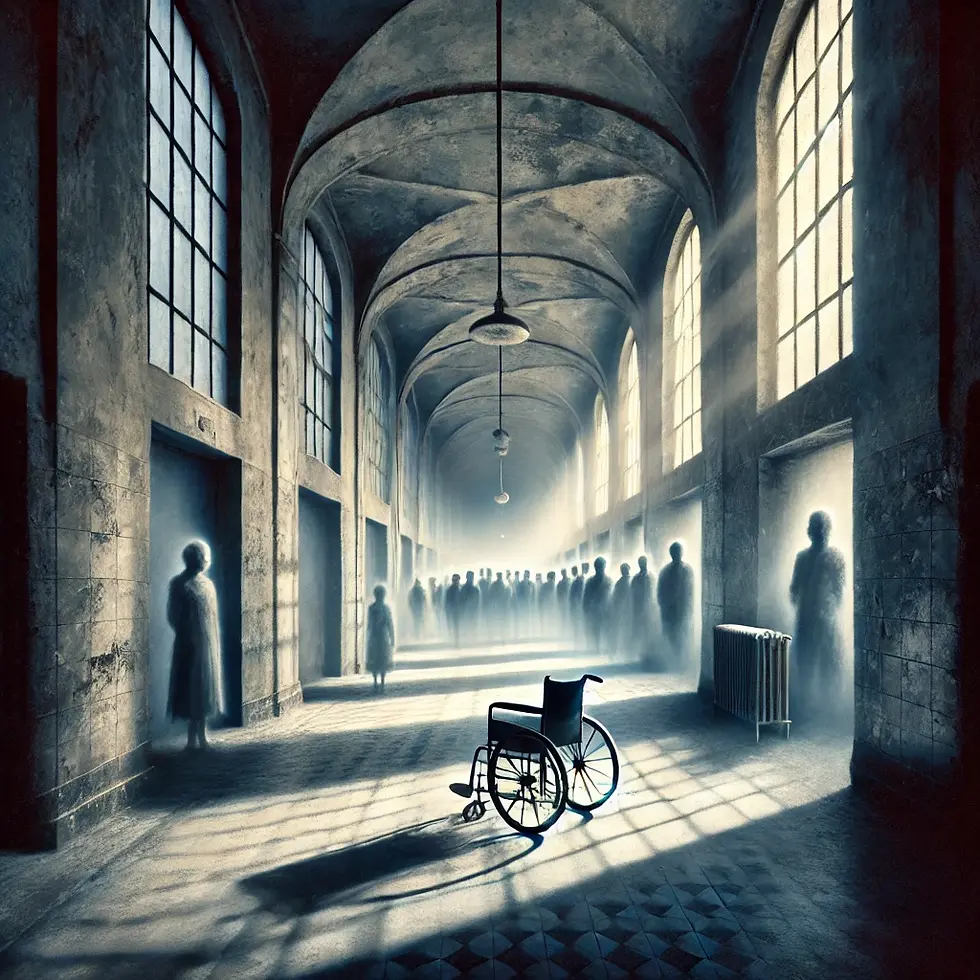
The Forgotten Cries: A Reflection on the T4 Program and the Value of a Human Life
- A HumanKind

- Mar 12
- 3 min read
They called it mercy. A quiet whisper, wrapped in bureaucracy, sealed with a stamp.
A name on a list. A date in a ledger. A life reduced to an equation.
Between 1939 and 1945, under the code name Aktion T4, the Nazi regime systematically murdered an estimated 275,000 to 300,000 people—men, women, and children deemed “unworthy of life.” The victims were not soldiers. They did not fight. They did not resist. They simply existed in a way the world had decided was inconvenient.
Mental illness. Physical disability. Neurological disorders. Poverty. Old age.
Each condition became a sentence.
At first, the doctors hesitated. Not all, but some. They had sworn an oath.
But words are malleable in the hands of power.
It is for their own good, they were told.
It is for the good of the nation.
It is science, not cruelty.
It is necessary.
And so, the pens moved. The doors locked. The gas valves turned.
The Machinery of Murder
It began with forced sterilizations, a slow erosion of autonomy. Then came the letters—families were told that their loved ones were being transferred to “specialist hospitals” for better care. Instead, they were sent to one of several killing centers, such as Bernburg and Hartheim, where carbon monoxide filled the chambers.
It was clinical.
It was efficient.
It was murder, disguised as medicine.
Some were not even given the dignity of a gas chamber. They were starved. They were overdosed. They were left to wither in their beds, fading into silence as the world looked away.
The program expanded. First, the institutionalized. Then, children. Then, anyone whose existence could be deemed a burden. Aktion T4 did not end with the war—it simply evolved, bleeding into the systematic genocide of the Holocaust.
The Ghosts That Linger
The world likes to remember the bold, the fallen heroes, the battles won and lost.
But who remembers the ones who never fought?
Who speaks for the child who could not walk?
For the mother whose mind fractured under the weight of a world that offered no help?
For the elderly man whose shaking hands made him less useful?
There are no grand memorials for them. No annual tributes.
Their names are footnotes in history books, if they appear at all.
But they were here.
They were real.
And they were loved.
Among them were:
Olga Benário Prestes (1908–1942): A German-Brazilian communist militant, extradited from Brazil to Germany and executed at Bernburg Euthanasia Centre.🕯️
Käthe Leichter (1895–1942): An Austrian economist and women’s rights activist, murdered at Bernburg.🕯️
Irma Eckler (1913–1940): A German woman of Jewish descent, arrested for her relationship with a non-Jewish man, killed during the T4 program.🕯️
Ida Maly (1894–1941): An Austrian painter, deemed mentally ill, murdered at Hartheim Euthanasia Centre.🕯️
Maria Karoline von Sachsen-Coburg-Gotha (1899–1941): A member of the royal family, killed at Hartheim due to schizophrenia.🕯️
Friederike (Friedl) Reichler Roth (1900–1940): Wife of writer Joseph Roth, murdered at Hartheim.🕯️
Henny Schermann (1912–1942): A German-Jewish woman, targeted for her sexuality and heritage, killed at Bernburg.🕯️
Rosa Manus (1881–1942): A Dutch feminist and peace activist, murdered during the T4 program.🕯️
Teodor Drapiewski (1880–1942): A Polish Catholic priest, victim at Hartheim.🕯️
Werner Sylten (1893–1942): A German theologian, murdered at Hartheim.🕯️
These names are but a few among countless others whose lives were extinguished under the guise of mercy.
What It Means Today
History does not remain in the past. It echoes.
It seeps into policies, into rhetoric, into the way we define worth.
It whispers in the decisions we make about healthcare, about access, about whose suffering is deemed acceptable.
When resources grow scarce, who is left behind?
When we measure value in productivity, who is discarded?
When we speak of the greater good, whose life becomes expendable?
These are not just questions of history. They are questions of now.
To Remember Is to Resist
To tell their stories is an act of defiance.
To say their names is an act of rebellion.
To believe that every life—regardless of ability, wealth, or circumstance—has value is a radical act in a world that still finds ways to measure worth.
And so, we remember.
Not because history is comfortable.
Not because it is easy.
But because the moment we forget, we risk repeating it.
Their names were stolen. Their voices silenced. But we can still listen.
Sources:
United States Holocaust Memorial Museum: https://encyclopedia.ushmm.org/content/en/article/euthanasia-program
Friedlander, Henry. The Origins of Nazi Genocide: From Euthanasia to the Final Solution. University of North Carolina Press, 1995.
Evans, Richard J. The Third Reich at War. Penguin Books, 2009.
Lifton, Robert Jay. The Nazi Doctors: Medical Killing and the Psychology of Genocide. Basic Books, 1986.
Memorial and Information Site for the Victims of National Socialist “Euthanasia” Killings: https://www.stiftung-denkmal.de/en/memorials/memorial-and-information-site-for-the-victims-of-national-socialist-euthanasia-killings/



Comentários